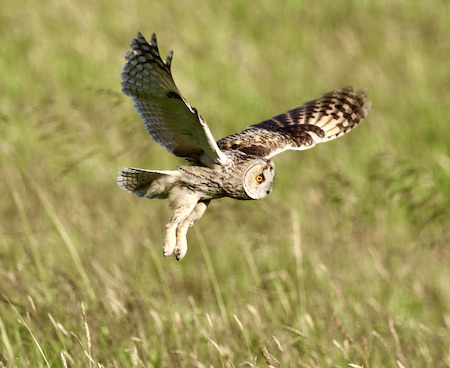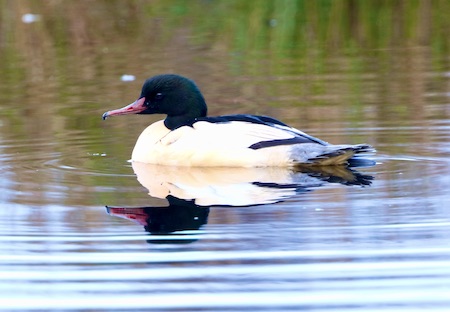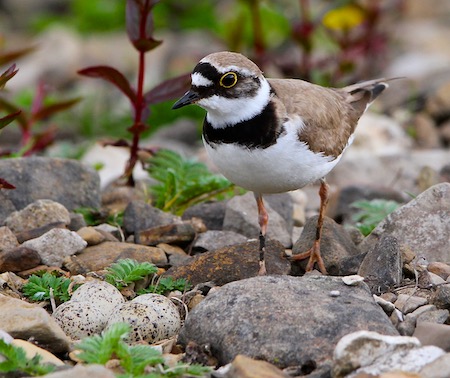November 27, 2022 at 7:19 pm
 For three months last summer I spent time in the hills filming three different hunting male Long Eared Owls. They were memorable nights and I took hundreds of photos so lets have a look at some of the also rans.
For three months last summer I spent time in the hills filming three different hunting male Long Eared Owls. They were memorable nights and I took hundreds of photos so lets have a look at some of the also rans.
The blog photo is interesting in that the eyes look yellow and not orange as they all were. It is just a matter of the evening light and the angle of its head – in the next photo his eyes were orange! www.facebook.com/gordonyateswildlife
November 20, 2022 at 8:23 pm
 The exciting thing about wildlife photography is that you never know what subject will present itself to you. One morning last week I set out before sunrise to try and find a local Kingfisher. As I reached the canal out in the middle was a male Goosander. It was only there a few seconds, there was no light,.but I managed to take a few photos despite the conditions. What will appear next?www.facebook.com/gordonyateswildlife
The exciting thing about wildlife photography is that you never know what subject will present itself to you. One morning last week I set out before sunrise to try and find a local Kingfisher. As I reached the canal out in the middle was a male Goosander. It was only there a few seconds, there was no light,.but I managed to take a few photos despite the conditions. What will appear next?www.facebook.com/gordonyateswildlife
November 13, 2022 at 8:34 pm
 Following on from last weeks blog on moorland reservoirs this week we highlight one of its success stories.
Following on from last weeks blog on moorland reservoirs this week we highlight one of its success stories.
The Little Ringed Plover is one of our rarest breeding birds and I have to obtain a special Permit to go anywhere near their nest. Four eggs are laid on the gravel bed of a moorland reservoir so if the water levels are high they are unable to breed. This years drought was perfect for them and they had one of their best seasons for a long time. www.facebook.com/gordonyateswildlife
November 6, 2022 at 3:41 pm
 This weeks photo is of Watergrove reservoir which is typical of the dozens of reservoirs that I have filmed at over the last fifty years. In the early years you would never find Great Crested Grebes breeding at the reservoir but all that has changed. They are just as happy now to anchor their nest to a floating Willow as they would be breeding in a Cheshire reed-bed.So always check the Willows on a moorland reservoir and you may find the stunning Great Crested Grebe. www.facebook.com/gordonyateswildlife
This weeks photo is of Watergrove reservoir which is typical of the dozens of reservoirs that I have filmed at over the last fifty years. In the early years you would never find Great Crested Grebes breeding at the reservoir but all that has changed. They are just as happy now to anchor their nest to a floating Willow as they would be breeding in a Cheshire reed-bed.So always check the Willows on a moorland reservoir and you may find the stunning Great Crested Grebe. www.facebook.com/gordonyateswildlife
 For three months last summer I spent time in the hills filming three different hunting male Long Eared Owls. They were memorable nights and I took hundreds of photos so lets have a look at some of the also rans.
For three months last summer I spent time in the hills filming three different hunting male Long Eared Owls. They were memorable nights and I took hundreds of photos so lets have a look at some of the also rans.

 The exciting thing about wildlife photography is that you never know what subject will present itself to you. One morning last week I set out before sunrise to try and find a local Kingfisher. As I reached the canal out in the middle was a male Goosander. It was only there a few seconds, there was no light,.but I managed to take a few photos despite the conditions. What will appear next?www.facebook.com/gordonyateswildlife
The exciting thing about wildlife photography is that you never know what subject will present itself to you. One morning last week I set out before sunrise to try and find a local Kingfisher. As I reached the canal out in the middle was a male Goosander. It was only there a few seconds, there was no light,.but I managed to take a few photos despite the conditions. What will appear next?www.facebook.com/gordonyateswildlife Following on from last weeks blog on moorland reservoirs this week we highlight one of its success stories.
Following on from last weeks blog on moorland reservoirs this week we highlight one of its success stories. This weeks photo is of Watergrove reservoir which is typical of the dozens of reservoirs that I have filmed at over the last fifty years. In the early years you would never find Great Crested Grebes breeding at the reservoir but all that has changed. They are just as happy now to anchor their nest to a floating Willow as they would be breeding in a Cheshire reed-bed.So always check the Willows on a moorland reservoir and you may find the stunning Great Crested Grebe. www.facebook.com/gordonyateswildlife
This weeks photo is of Watergrove reservoir which is typical of the dozens of reservoirs that I have filmed at over the last fifty years. In the early years you would never find Great Crested Grebes breeding at the reservoir but all that has changed. They are just as happy now to anchor their nest to a floating Willow as they would be breeding in a Cheshire reed-bed.So always check the Willows on a moorland reservoir and you may find the stunning Great Crested Grebe. www.facebook.com/gordonyateswildlife